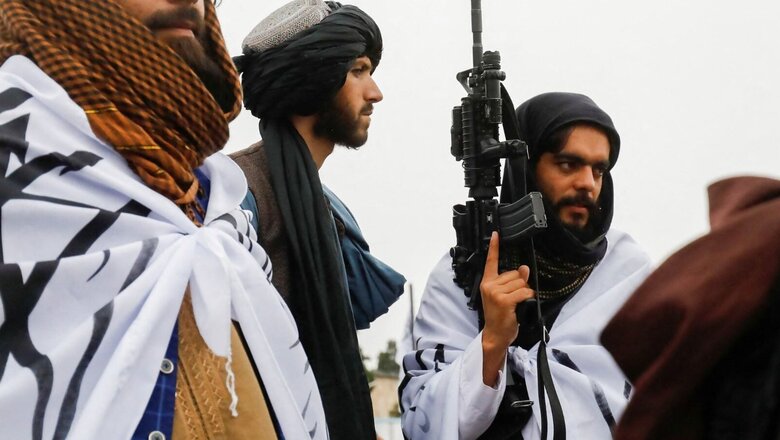
views
Twenty years of counter-insurgency and counter-terrorism operations to clean the swamps of terrorism in the AfPak region and its surrounding areas, hundreds of billions of dollars spent, and thousands of lives lost, have all come to nought within one year of Afghanistan being abandoned, nay handed over, to the Taliban. No matter what spin is put on the US exit from Afghanistan in such unseemly haste, and regardless of the boasts of building capabilities to take out terrorists with “over-the-horizon” operations or claims of successfully managing to ‘disrupt, degrade, dismantle and destroy’ Al Qaeda and other terror groups, the facts on the ground reveal a resurgence of radical Islamist terror groups, both regional and international. The re-surfacing of the terror groups with renewed energy and motivation has been apparent over the last one year. Organisationally, almost all the regional and trans-national jihadist groups have started consolidating themselves. Their propaganda, training and recruitment drives have restarted. Operationally, however, while the regional jihadist terror groups have become very active, the trans-national groups like Al Qaeda have still some way to go before they can effectively plan, coordinate and conduct major attacks.
Around the first anniversary of the Taliban capture of Kabul, a series of incidents that indicate that the threat of terrorism in the AfPak region is once again starting to metastasize. There are also new alignments and understandings, making for strange bedfellows who are trying to navigate through the treacherous terrain of terrorism while protecting, even furthering, their interests. The killing of the Al Qaeda chief Ayman al-Zawahiri who was living in an upscale locality in the heart of Kabul, presumably under the protection of the Taliban, is one of the most significant developments in recent weeks. Although the Western and even local AfPak media has not given the salience that Zawahiri’s elimination deserved, it has really stirred up the witches brew of terrorism in the region. The Taliban leadership has taken umbrage over the US action. Without naming Pakistan, the Taliban have held ‘a neighbouring country which allowed the use of its airspace for the drone attack’ equally responsible for the assassination of Zawahiri. The statement has warned of consequences if such facilitation is provided in the future. What is clear from the Taliban reaction is that they have not accepted the Pakistani denials of any involvement in the attack. But even more importantly, the Taliban outrage on the Zawahiri assassination is an emphatic statement of the close ties that exist between the Al Qaeda and the Taliban.
The Taliban warning to Pakistan comes at a time when the Islamic Emirate is acting as mediator and facilitator in the talks between the Pakistan authorities and the Tehrik-e-Taliban Pakistan (TTP). They have played a role in negotiating a ceasefire between the Pakistan security forces and the TTP. But despite the ceasefire, and the talks between representatives of the Pakistani state and the TTP, both sides are continuing to attack each other, albeit without claiming these attacks. Within a couple of days of Zawahiri’s killing, a top TTP commander Umar Khalid Khurasani was killed in an explosion along with two leading commanders, inside Afghanistan. It is still not clear whether Khurasani was taken out in an IED blast or a drone strike (the latter being quid pro quo for Pakistani cooperation in the Zawahiri execution). Khurasani was considered one of the most dangerous and effective TTP commanders and someone who wasn’t exactly rooting for the peace talks with Pakistan. While the TTP took Khorasani’s killing in its stride and did not break off the talks with Pakistan, a suicide attack on Pakistan Army in North Waziristan killing four soldiers is believed to be TTP payback.
The peace talks between TTP and Pakistan have in fact created space for TTP to spread out into the areas that they controlled before they were pushed out in multiple military operations by the Pakistan army between 2008 and 2014/15. Panic bells are already ringing in the Malakand division (Swat and its surrounding areas) where the TTP militants are not only making inroads but also clashing with security forces. In both South and North Waziristan there are reports of clashes and ambushes of the Pakistan security forces. Target killings of locally influential persons, extortion, intimidation, kidnappings are once again raising the spectre of a return to the times when the TTP held sway over the region.
Many Pakistani analysts accuse the Pakistan Army leadership of conceding ground to TTP to buy peace. There are allegations that the former ISI chief and Peshawar Corps Commander Faiz Hamid cut deals with the TTP to propel the peace talks. This suited both the Taliban and the TTP because without really conceding anything substantial, they were able to make an ingress into areas from where they had been expelled. The problem is that while states tend to take a somewhat myopic view in negotiating peace with jihadist organisations, the latter approach talks to gain not only a tactical advantage – gain a foothold, get some breathing space and/or relief from military operations – but also from a strategic viewpoint. All jihadist organisations have an open-ended agenda. Their ideological DNA is expansionary. They operate with a millenarian mindset and agenda in which a few years, even few decades, are immaterial. Since they have limited firepower and are not often times in no position to frontally confront superior state forces, they rely on a war of attrition, or if you will a sort of jihadist salami-slicing approach. This means grabbing what they can when they can and then using that space to keep expanding and extending their footprint. They move in stages: if it is the Waziristans and Swat today, it will be Balochistan tomorrow, Punjab and Sindh the day after, Kashmir after that and so on and so forth. In the meantime, they will keep spreading their ideology and set up their networks in areas where they get any traction.
Within the Pakistan Army there is some realisation that the Taliban will never break with the TTP. Groups like TTP, Al Qaeda, the Uzbek, Tajik and Baloch militant organisations give leverage to Taliban over their neighbours. That is probably an important reason why the Taliban have not expelled or even taken any serious action against the Baloch separatist organisations based in Afghanistan. If anything, there are reports and indications of tactical level alliances between the Islamist groups and Baloch nationalist groups. As far as the TTP is concerned, the Taliban have made it clear that they will not move against TTP. They have advised Pakistan to negotiate with TTP to bring peace. In the process, the Taliban have placed themselves firmly as the arbiters of what happens inside Pakistan.
The dilemma for the Pakistan Army is that if it ends the negotiations, it would mean undertaking military operations which are going to prove expensive in men, material and money; on the other hand, continuing with the negotiations means making space for the TTP. Amidst the growing voices inside Pakistan against the re-emergence of TTP – massive protests have taken place in Swat and Waziristan against the deteriorating security situation, and politicians in Islamabad have been looking askance at the Army’s policy on containing terrorism through negotiations — there are signs that the Pakistan Army might be reconsidering its policy towards the TTP. Faiz Hamid has been posted out and a new general and new policy seems to be in the works. Perhaps the negotiations track will not be abandoned, but there could be changes in the policy and red-lines laid down more clearly by the military.
The Taliban, of course, have their own vulnerabilities. The Islamic State Khorasan (ISK) has started posing a major challenge to the Emirate. Although the Taliban scoff at the threat that ISK presents, the fact of the matter is that the ISK has been bleeding the Taliban and puncturing holes in claims that the Taliban have secured Afghanistan. Ambushes, bomb-blasts, sophisticated assassinations (including of the well-protected Taliban ideologue Rahimullah Haqqani) have seriously undermined the Taliban regime, in quite the same way that the Taliban undermined the ancient regime.
The Al Qaeda, while quiet, is believed to be seething and seeking vengeance for Zawahiri’s killing. This could complicate Taliban efforts to calibrate the actions and operations of its terrorist associates. Up north, there is the National Resistance Front which is fighting the Taliban. Chances of this resistance becoming bigger are high, especially given the policies of Taliban that are alienating the ethnic minorities. The Shia Hazaras who seemed to have reconciled to the Taliban rule are also becoming restive and the defection of Mawlawi Mehdi, a top Hazara commander from Taliban ranks — he has been killed by the Taliban —suggests that trouble could be brewing in the Hazara belt. And all this is happening amidst reports of deep divisions within the Taliban ranks. The various Taliban factions are contending for power and while there has been no internecine warfare, the possibility of something giving way to pit these factions against each other cannot be ignored.
Given that the Taliban have no idea of what constitutes governance and they have no financial or administrative experience, much less financial resources, to run even a semi-modern state is also going to fuel discontent, which in turn will play into the hands of Taliban’s rivals. While a number of countries, including India, have engaged the Taliban, there is as yet no sign of any formal diplomatic recognition of the Emirate. Most countries are hedging their bets and feeling the waters to see how far the Taliban will address their concerns. For their part, the Taliban seem to be stringing along these CTS and using them for their own agenda. For instance, engagement with India is an effective instrument to signal to Pakistan that they have leverages that go beyond the TTP.
India is also useful because it has the wherewithal to give some assistance and perhaps the diplomatic heft to intercede on behalf of the Taliban with the West, something that Pakistan has been completely unsuccessful in doing. For India, a presence in Kabul gives her a toehold back into Afghanistan, for whatever that is worth. Meanwhile, there seems to be something cooking between the US and Pakistan on the issue of Afghanistan — the Zawahiri and Khorasani assassinations were perhaps just an example of some kind of understanding being worked out to contain the fallout from the Taliban controlled Emirate and even cooperate on some operations against high value targets.
That the AfPak region is in a flux is a no-brainer. But what is becoming increasingly clear is that a piecemeal or selective approach to jihadist terror groups will never really end the menace that the jihadist phenomenon poses.
Because these groups are part of a whole, cutting side deals with one group of jihadists to secure a particular country from being targeted ends up making everyone insecure. Unfortunately, this is a lesson that no country is as yet ready to learn, much less imbibe. The temptation to use some of these groups against rivals only empowers and emboldens the jihad industry. But since yielding to this temptation is easier than resisting it, countries and peoples in the region and beyond need to brace themselves from the fallout of the vipers’ nest that has been left behind in the form of the Islamic Emirate of Afghanistan.
The writer is Senior Fellow, Observer Research Foundation. The views expressed in this article are those of the author and do not represent the stand of this publication.
Read the Latest News and Breaking News here

















Comments
0 comment